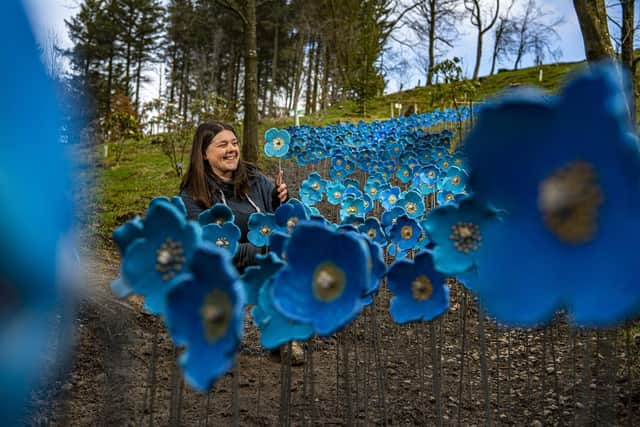Himalayan Garden and Sculpture Park: Why 1,300 blue poppies have been installed
This striking sculpture, of 1,300 ceramic poppies painted by hundreds of hands, was never intended as a symbol of all that has passed.
But with every person involved each rare bloom has taken on life of its own, realising so much more than imagined - and two years later than planned.
Advertisement
Hide AdAdvertisement
Hide AdTo some, this cascade of colour is now memoriam to a loved-one lost, while to others it represents a joyous social reunion.


To artist Anna Whitehouse it has come to mirror an emotional intensity, defining a nation's sentiment in Bursting from the Slumber.
"I wouldn't have given it that name two years ago," she said simply. "That wasn't the piece of art being made.
"Now it is this re-emergence, after such a long winter. There was definitely a feeling of real, pent-up energy from people, and this tries to capture a bit of that as well."
Advertisement
Hide AdAdvertisement
Hide AdThe sculpture was commissioned in 2019 by North Yorkshire's Himalayan Garden and Sculpture Park, one of the few places the Meconopsis blue poppy can be grown.
It takes a certain soil, and this fertile valley is well-known for its Himalayan blue, alongside the North’s largest collection of rhododendrons, azaleas and magnolias.
But then everything was put on pause, for two years. Instead of visitors to the sculpture park it has been schoolchildren and others in public workshops that have created the poppies.
As time went on, Miss Whitehouse found that in a poignant way, they created a connection. Some people dedicated them to a loved one, or recorded what lockdown meant to them.
Advertisement
Hide AdAdvertisement
Hide AdOthers took the blank canvas and made it their own, revelling in being together with friends once more and the therapy of artistic creation.
She said: "When we designed it, that correlation wasn't there. It has become a lot more. That idea, that two years later we would have this 'emergence', we just couldn't have imagined."
Once considered a myth, the blue poppy is incredibly rare, almost impossible to grow in the UK.
Much claim has been made to its discovery, with reports dating back to the 1800s of a 'blue lake' that on closer inspection was made from thousands of flowers. Other reports suggest it was discovered in a failed Everest expedition in 1922.
Advertisement
Hide AdAdvertisement
Hide AdNow there are 1,300 of them in clay, carefully planted over 80sqm. It's taken 450 people over two weeks to create, and a quarter tonne of clay - more than Miss Whitehouse might use in a year.
Each has been handmade, glazed, fired, and painted, in colours that emerge in the kiln from deepest navy to a vibrant, bright turquoise.
Ms Whitehouse said: "Different people's hands do different things. There's the decoration on the back, the way they've moved the petals to shape them, the kiln reactions and colours.
"Then it's seeing them differently, almost like a river flowing down the hillside.
Advertisement
Hide AdAdvertisement
Hide Ad"Each poppy has been personalised by its maker; messages of freedom, names of family and friends, and those they have lost," she added.
"As an artist, to be able to facilitate such a positive and healing experience is humbling.
"It symbolises the idea of hibernating through winter, and then all this spring growth."
The Himalayan Garden & Sculpture Park, near Ripon, opens to the public for the season from April 12.
Advertisement
Hide AdAdvertisement
Hide AdAmong those involved in the poppies creation were at public workshops and Pottery Pals in Harrogate, Thirsk's The Arts Collective, and students at Harrogate College, Roundhay St John's Primary and Outwood Academy.
Gardens owner Will Roberts said: "The Himalayan Poppies we grow in the garden are always well received, this new installation will remind us of their mystical blue beauty throughout the year.”
